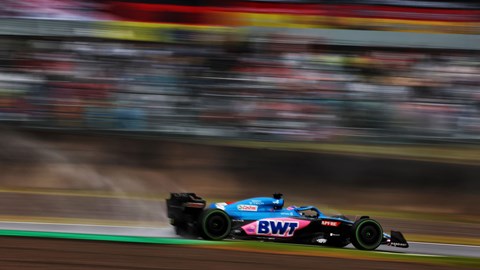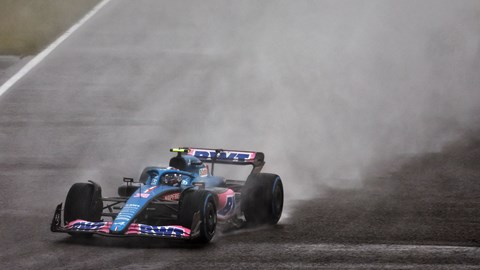► Does F1 still race in the wet?
► What’s behind farces like Spa 2021 and Japan 2022
► Esteban Ocon and Pat Fry explain
Some of the best performances in F1 history have been in the wet; think Monaco 1984, Silverstone 2008 and of course Canada 2011. It’s no coincidence that most of those are a decade old or more; in recent years, the FIA (Formula One’s governing body) has become terrified of the wet stuff.
Rather than stunning showcases of skill in tricky conditions, we now have such farces as Belgium 2021, Singapore 2022 or even the Japanese GP earlier this month. Rather than making the world’s best drivers adapt to the conditions, fans now get delays, safety car laps and if we’re lucky; a rolling start.

And the worst part? When the race does get going, it’s usually a short sprint due to lighting or timing constraints.
What’s happened?
Ultimately, it’s not just down to the FIA, but to a combination of rules and tyres that simply don’t agree with more extreme conditions. The first problem? The wet tyres themselves.
‘In reality, we’ve got two types of wet tyre,’ Alpine’s Pat Fry told CAR magazine just before the Japanese GP. ‘The intermediate will be the clear favourite unless it’s so wet that you can’t actually get around the track.’
Therein lies the problem. Described as ‘survival tyre’ at the same GP by Red Bull’s Christian Horner, the wet tyre is a last resort, and made of the softest compound Pirelli makes. That’s great for heating it up fast, but not so great for endurance.

‘The tread will wear away every lap, so you’ll go maybe 0.2 seconds a laps slower,’ continues Fry. ‘Once you start losing the sharp edges of the tyre, you don’t clear the water away so well you lose grip from it.’
Fry is quick to point out that some low-grip tracks let you ‘get away with’ using a full wet tyre, but most tracks – including high-load ones like Suzuka will punish the softest compounds – and annihilate the super sticky wets. ‘Particularly at [Suzuka], which is very high speed, with the loading and in the Ss, you will destroy the tyre straightaway,’ he confirms.
‘The wet tyre I guess, will be five seconds a lap slower than the intermediate. So, it’s, it’s a clear choice.’
As you’d expect, the lack of wet tyre performance is a key issue for the drivers too. ‘The wet tyres cope better with aquaplaning in heavy rain than the intermediates,’ admits Ocon at the Paris motor show a week later. ‘But we can’t use the wets because they don’t give us enough performance in corners. You must take the risk and go straight away to intermediates, even if there is a chance of aquaplaning – we must risk it, everybody will risk it.’
New rules
This year, teams and drivers also have to contend with something other than suboptimal tyres: New aerodynamic rules introduced this year to promote overtaking have had a negative effect on wet weather racing.
‘These cars throw the spray much higher [than last year’s cars], so you have even less visibility,’ Ocon told CAR. ‘We can’t see anything – that’s the first problem. We can drive alone, in practice, but in a race start situation for example you can’t drive like this. It’s dangerous. It’s not fun; it’s not nice.’

The reason for this lies in the new way the cars generate aero grip. The 2022 rules require cars to generate more downforce as a percentage from the diffuser and floor of the car; making them easier to follow, but throwing more spray out and up than before.
‘It’s a problem,’ admits Fry. ‘Really, that’s more the main thing. And I guess, as we generate a lot of downforce from the underbody of the car, you still get a lot of spray going up. When I guess last [year] it would go off and out as well.’
The solution?
For this writer, it looks as though the best fix would be a wet tyre with the same compound as the more robust intermediate. That way teams would benefit from the water-clearing grooves of a wet but gain more endurance, making the tyre worth putting on in the first place.
Whatever the solution, one needs to be found – and fast. Wet races have always been an important part of F1, giving us some of the most epic, unusual, and impressive drives and finishes in the sport’s history. We need them to stay.